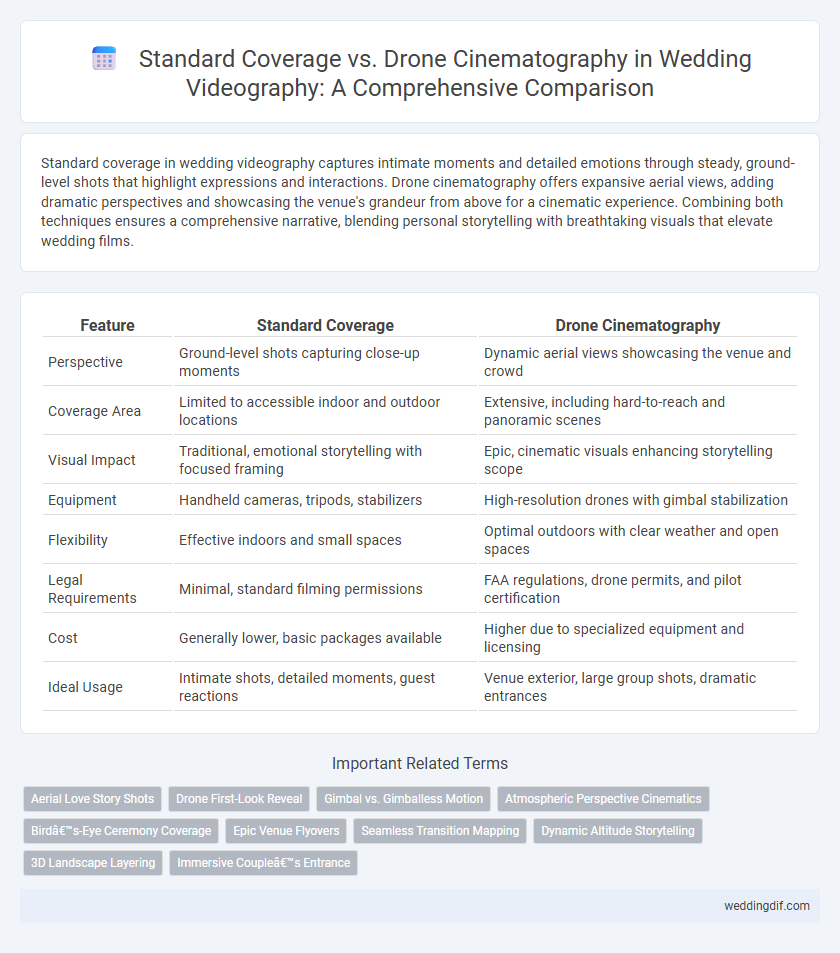Standard coverage in wedding videography captures intimate moments and detailed emotions through steady, ground-level shots that highlight expressions and interactions. Drone cinematography offers expansive aerial views, adding dramatic perspectives and showcasing the venue's grandeur from above for a cinematic experience. Combining both techniques ensures a comprehensive narrative, blending personal storytelling with breathtaking visuals that elevate wedding films.
Table of Comparison
| Feature | Standard Coverage | Drone Cinematography |
|---|---|---|
| Perspective | Ground-level shots capturing close-up moments | Dynamic aerial views showcasing the venue and crowd |
| Coverage Area | Limited to accessible indoor and outdoor locations | Extensive, including hard-to-reach and panoramic scenes |
| Visual Impact | Traditional, emotional storytelling with focused framing | Epic, cinematic visuals enhancing storytelling scope |
| Equipment | Handheld cameras, tripods, stabilizers | High-resolution drones with gimbal stabilization |
| Flexibility | Effective indoors and small spaces | Optimal outdoors with clear weather and open spaces |
| Legal Requirements | Minimal, standard filming permissions | FAA regulations, drone permits, and pilot certification |
| Cost | Generally lower, basic packages available | Higher due to specialized equipment and licensing |
| Ideal Usage | Intimate shots, detailed moments, guest reactions | Venue exterior, large group shots, dramatic entrances |
Introduction to Wedding Videography: Standard vs Drone
Standard wedding videography captures intimate close-up moments and detailed interactions using handheld cameras and steady cams, ensuring high-quality footage of key events like vows and speeches. Drone cinematography offers dynamic aerial perspectives, showcasing venue landscapes and large gatherings from unique vantage points that traditional cameras cannot achieve. Combining both methods enhances storytelling by blending personal moments with expansive, cinematic visuals that elevate the overall wedding film experience.
Standard Coverage: What’s Included in Traditional Wedding Videography
Standard coverage in traditional wedding videography typically includes full-day filming of key events such as the ceremony, vows, speeches, and first dance, using handheld or tripod-mounted cameras for steady, clear footage. This approach often features multiple camera angles, professional audio recording, and edited highlights that capture the emotional essence and important moments of the day. Unlike drone cinematography, standard coverage relies on ground-level perspectives and classic storytelling techniques to create a timeless video keepsake.
The Rise of Drone Cinematography in Weddings
Drone cinematography has revolutionized wedding videography by capturing dynamic aerial perspectives that standard coverage cannot achieve. High-resolution drones equipped with gimbals provide smooth, cinematic shots from unique angles, enhancing the storytelling of wedding highlights. The growing demand for stunning aerial footage reflects the trend towards innovative, immersive wedding experiences that standard ground-level cameras alone cannot deliver.
Visual Impact: Ground Angles vs Aerial Perspectives
Standard coverage captures weddings with ground-level angles that emphasize close-up details, facial expressions, and intimate moments, providing a personal and emotional connection. Drone cinematography offers expansive aerial perspectives that showcase the venue's scale, surrounding landscapes, and dynamic movement, delivering a cinematic and dramatic visual impact. Combining both techniques enhances storytelling by blending detailed emotions with sweeping panoramic views, elevating the overall wedding video experience.
Storytelling Differences: Traditional Footage vs Cinematic Drone Sequences
Standard coverage captures weddings through intimate, close-up shots that emphasize personal emotions and key moments from a ground-level perspective, ensuring a detailed narrative of the day. Drone cinematography introduces expansive aerial views and dynamic cinematic sequences, offering a grander, more immersive storytelling approach that highlights the venue's landscape and event flow. Combining traditional footage with drone shots provides a balanced narrative, blending emotional intimacy with breathtaking visual context.
Cost Comparison: Standard Coverage vs Drone Enhancements
Standard wedding videography typically costs between $1,200 and $3,000, encompassing DSLR or cinema cameras and traditional filming techniques. Drone cinematography adds an average of $500 to $1,500 to the total package, reflecting expenses for specialized drone equipment, licensed operators, and post-production editing of aerial footage. Investing in drone enhancements offers dynamic aerial perspectives but requires budgeting for FAA permits and insurance, which can increase overall costs compared to standard coverage.
Venue Considerations: Where Drone Footage Shines
Drone cinematography excels in expansive outdoor wedding venues where aerial views capture the full landscape, garden layouts, and architectural features, enhancing the visual storytelling. Standard coverage remains ideal for intimate indoor settings, ensuring detailed shots of emotions and interactions without technical constraints. Venue accessibility, local drone regulations, and potential obstacles like trees or buildings are critical factors when integrating drone footage into wedding videography.
Legal and Safety Aspects of Drone Wedding Videography
Drone wedding videography requires strict adherence to aviation regulations, including obtaining necessary permits and pilot certifications to ensure legal operation during ceremonies. Safety measures must address no-fly zones, crowd proximity, and weather conditions to prevent accidents or liability issues. Standard coverage remains preferable where drone use may pose risks or regulatory challenges, offering consistent and compliant visual documentation.
Editing Styles: Integrating Drone Shots with Traditional Footage
Standard coverage captures essential wedding moments through stable, ground-level shots, offering clarity and emotional intimacy in editing. Drone cinematography introduces dynamic aerial perspectives that enhance storytelling with sweeping views and unique angles, creating visual contrast when integrated. Seamless blending of drone footage with traditional shots requires precise color grading, motion matching, and rhythm synchronization to maintain narrative flow and visual coherence.
Choosing the Right Videography Style for Your Wedding Day
Standard coverage captures traditional wedding moments with steady, close-up shots that emphasize emotional expressions and key events, ensuring clear footage of vows, speeches, and dances. Drone cinematography provides sweeping aerial views and dynamic perspectives, adding cinematic scale and creativity to highlight venue landscapes and guest interactions from above. Selecting the right videography style depends on your wedding venue, desired visual storytelling, and budget, with many couples opting for a combination to balance intimate details and expansive scenery.
Standard Coverage vs Drone Cinematography for weddings Infographic

 weddingdif.com
weddingdif.com